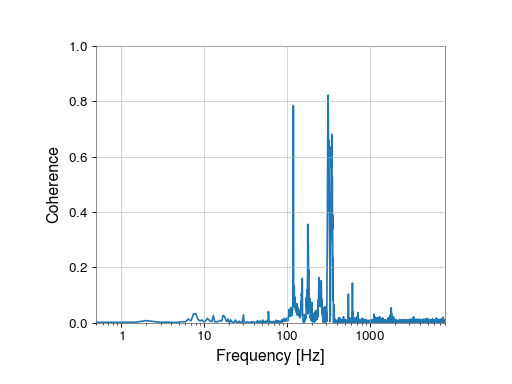4. Calculating the coherence between two channels¶
The coherence between two channels is a measure of the frequency-domain correlation between their time-series data.
In LIGO, the coherence is a crucial indicator of how noise sources couple into
the main differential arm-length readout.
Here we use use the TimeSeries.coherence() method to highlight coupling
of motion of a beam periscope attached to the main laser table into the
strain output of the LIGO-Hanford interferometer.
First, we import the TimeSeriesDict
from gwpy.timeseries import TimeSeriesDict
and then get() the data for the strain output
(H1:GDS-CALIB_STRAIN) and the PSL periscope accelerometer
(H1:PEM-CS_ACC_PSL_PERISCOPE_X_DQ):
data = TimeSeriesDict.get(
['H1:GDS-CALIB_STRAIN', 'H1:PEM-CS_ACC_PSL_PERISCOPE_X_DQ'],
1126260017,
1126260617,
)
hoft = data['H1:GDS-CALIB_STRAIN']
acc = data['H1:PEM-CS_ACC_PSL_PERISCOPE_X_DQ']
We can then calculate the coherence() of one
TimeSeries with respect to the other, using an 2-second Fourier
transform length, with a 1-second (50%) overlap:
coh = hoft.coherence(acc, fftlength=2, overlap=1)
Finally, we can plot() the
resulting data:
plot = coh.plot(
xlabel='Frequency [Hz]', xscale='log',
ylabel='Coherence', yscale='linear', ylim=(0, 1),
)
plot.show()
(png)

We can clearly see the correlation between the periscope motion and the strain data between 100 Hz and 1000 Hz. Once this was discovered the motion was damped by modifying the structure of the periscope itself, reducing the coupling into the gravitational-wave strain output.